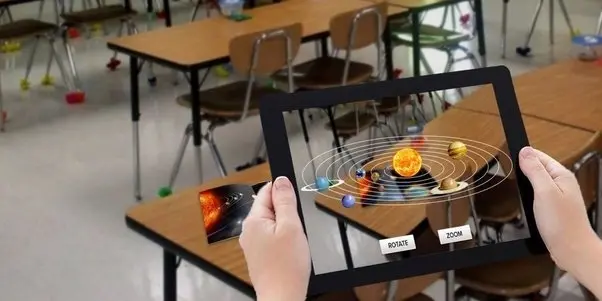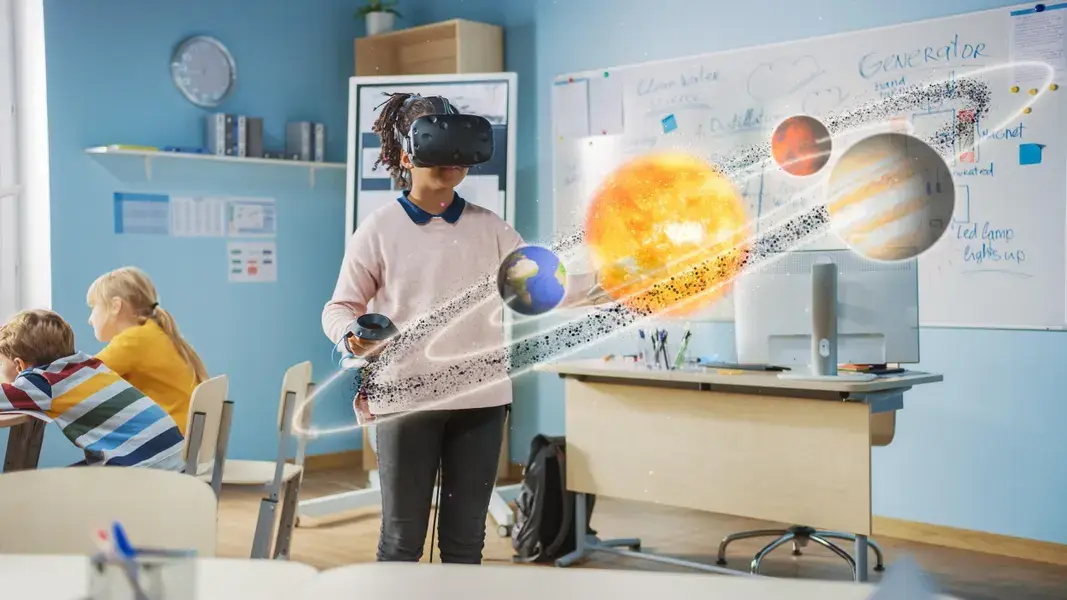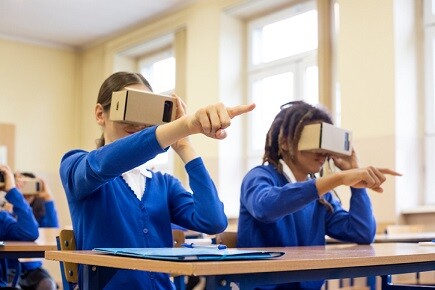Virtual Reality in Education: How Schools Can Use VR for Engaging Lessons
Virtual Reality (VR) is revolutionizing education by providing immersive and interactive learning experiences that enhance student engagement and...
You must be logged in to the LATechNet portal to view additional resources.
4 min read
 Aria - LATechNet Team
:
Apr 8, 2025 6:06:20 AM
Aria - LATechNet Team
:
Apr 8, 2025 6:06:20 AM

Imagine your students stepping into a history lesson and suddenly seeing dinosaurs roam the classroom, or diving into a science class where they explore the solar system up close. That's the magic of Augmented Reality (AR), a technology that adds digital elements, like images or sounds, into the real-world environment through devices such as smartphones or tablets. AR isn't just a futuristic idea anymore—it's quickly becoming a popular way to engage students and boost learning in classrooms all across the globe.
As AR technology continues to grow, it's essential for educators and school administrators to stay updated. Keeping pace with emerging technologies like AR not only helps schools stay relevant but also ensures students are prepared for a rapidly changing world. By understanding AR and its educational potential, schools can create exciting, interactive experiences that bring learning to life in ways we once only dreamed about.
Augmented Reality (AR) is a technology that layers digital information, such as images, sounds, or animations, over the real world. Unlike Virtual Reality (VR), which immerses users completely in a digital environment, AR enhances the real-world setting you're already in. Imagine pointing your phone at a historical landmark and instantly seeing facts and stories pop up on your screen—that's AR in action!
In education, AR helps students visualize complex concepts. For example, an AR app might bring a 3D model of a human heart into a biology classroom, allowing students to interactively explore how it functions. AR is also common in daily life, from Snapchat filters to navigation apps that overlay directions on real streets.
Schools are quickly adopting AR because of its engaging and interactive nature. According to teachng.com, nearly 80% of educational institutions are expected to integrate AR by 2030. Additionally, the AR education market is booming, projected to grow significantly—from US$ 3.47 billion in 2023 to US$ 55.84 billion by 2033 (globenewswire.com). Clearly, AR is becoming a key part of how educators bring lessons to life.
One of the standout benefits of using augmented reality (AR) in classrooms is significantly improved academic performance. Studies have shown that students who learn through AR can achieve up to a 33% increase in test scores compared to traditional methods (worldmetrics.org). This improvement stems from AR's ability to make learning interactive and engaging. By blending the digital and real worlds, AR helps students grasp complex concepts more clearly, making lessons more memorable and easier to understand.
Teachers have observed firsthand how AR can spark students' curiosity and enthusiasm. In fact, 73% of educators report that AR activities positively influence student engagement (worldmetrics.org). Imagine students exploring the solar system or dissecting virtual frogs right at their desks—AR activities like these captivate learners, especially in subjects that can traditionally seem challenging or dull. This increased attention makes lessons more enjoyable and motivates students to participate actively.
When students learn through augmented reality, the information sticks better. Research indicates that AR-based learning can boost retention rates by as much as 30% compared to traditional teaching methods (teachng.com). This happens because AR engages multiple senses and makes abstract ideas concrete and relatable. When students actively explore and interact with digital content layered over the real world, their brains form stronger connections, helping them remember information for longer periods of time.
Today, educators have access to a wide range of AR educational tools designed to make learning more interactive and engaging. Popular platforms like Merge EDU, CoSpaces Edu, and Google Expeditions offer immersive experiences that bring lessons to life. When picking the right AR tools, schools should look at compatibility with existing devices, functionality of features, overall educational impact, and ease of use. A great AR tool should enhance learning without causing frustration for teachers or students, fitting smoothly into daily classroom activities.
Integrating AR into the classroom isn't just about technology—it's about empowering teachers. Professional development is crucial for educators to feel comfortable and confident using AR effectively. Schools can offer workshops, webinars, and hands-on sessions tailored to teachers' needs. Providing ongoing support through online communities, resource libraries, and collaborative planning groups will help teachers smoothly weave AR into their lesson plans. Remember, well-supported teachers are more likely to embrace new tech and use it creatively!
Introducing AR can come with its share of hurdles. Common obstacles include tight budgets, limited technological infrastructure, and a lack of teacher training. To overcome these challenges, schools can start small, piloting AR in select classrooms to manage costs and gather feedback. Building strategic partnerships with tech companies or applying for educational grants can ease budget pressures. Investing in infrastructure upgrades gradually, along with continuous professional development, will ensure teachers and students get the most from AR experiences.
Emerging AR Technologies and Educational Innovations
Augmented Reality (AR) technology is growing quickly, and the next few years promise exciting changes for classrooms. Soon, we'll likely see AR glasses become lightweight, affordable, and easy to use, allowing students to interact naturally with virtual objects and environments. Imagine biology students exploring a virtual rainforest or history classes visiting ancient cities without leaving their desks! Additionally, advancements in artificial intelligence (AI) could personalize AR lessons, adapting content to each student's learning pace and style. These innovations could transform learning into a more engaging, immersive, and personalized experience, helping students grasp complex concepts more easily and making education more inclusive for diverse learners.
Preparing Schools for Future AR Integration
To benefit from these exciting AR developments, schools must start preparing now. Investing in robust network infrastructures, such as reliable Wi-Fi and faster internet connections, will ensure AR tools function smoothly. Additionally, gaining support from teachers, parents, and school leaders is crucial. Providing training workshops and demonstrating AR's educational value can help build enthusiasm and confidence among stakeholders. Schools will also need to update their policies to address responsible AR use, student privacy, and safety. By proactively addressing these factors, educators and administrators can smoothly welcome AR into classrooms, enhancing students' learning experiences and preparing them effectively for the future.
LATechNet is a trusted partner that understands the unique needs of schools ready to explore augmented reality (AR). As an experienced IT firm specializing in education, they know the importance of smoothly integrating new technology into classrooms.
LATechNet provides personalized services to ensure schools get the most from AR. They begin by assessing your current IT setup, recommending upgrades specifically suited for AR technology. From there, they create customized AR solutions, handling everything from planning and deployment to ongoing technical support. Educators aren't left alone either—LATechNet offers comprehensive training and professional development programs, helping teachers confidently use AR tools.
Moreover, LATechNet provides reliable ongoing technical assistance, reducing downtime and disruptions. Their commitment is clear: helping schools successfully use AR to boost student engagement and improve learning outcomes, ensuring lasting academic success.

Virtual Reality (VR) is revolutionizing education by providing immersive and interactive learning experiences that enhance student engagement and...

Introduction Remember when classroom technology meant overhead projectors and bulky desktop computers? We've come a long way since then! Educational...

The article explores how gamification can transform traditional educational methods by incorporating game-like elements such as scoring, badges, and...